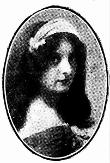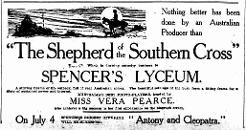AustLit
Latest Issues
AbstractHistoryArchive Description
'The story opens with the reading of a will, whereby a fortune is left to the heroine on condition that she marries one of two cousins. These two men are the hero and villain respectively. The latter succeeds in disgracing his rival in the eyes of the girl, whereupon she marries the villain. The innocent man emigrates to Australia, and it is there that the most interesting and dramatic events of the story occur. Some years later the heroine takes ill, and is accompanied by her husband on a health trip to Australia. While making the final stages of the journey in a coach they are held up by bushrangers. The man and his wife escape, but get lost in the bush. After wandering about for days they are overcome by exhaustion. The villain leaves the heroine to die in a dust storm, and struggles on. He eventually arrives at the hut of his cousin, and is taken in and revived by a girl who in reality is his own daughter — the daughter of a previous marriage. The heroine is picked up by her old lover, and is also taken to the hut. Then the climax is reached. After confessing to the wrongs he did the hero, the villain dies. The reader can imagine the rest. Although the long arm of coincidence is stretched to its extreme, the plot is good, and throbs with dramatic incidents.'
Source:
'Shepherd of the Southern Cross', Sunday Times, 14 June 1914, p.6.
Notes
-
Nell Shipman, Alexander Butler, and Stanley Twist were all 'imported' by Charles Cozens Spencer as an inducement for Australasian Films to make this, their first film: Shipman and Twist were working in Hollywood, and Butler in British film.
Publication Details of Only Known VersionEarliest 2 Known Versions of
Works about this Work
-
American Combine : Australasian Films Ltd., and Block Bookings
2015
single work
criticism
— Appears in: Studies in Australasian Cinema , vol. 9 no. 3 2015; (p. 241-252) 'The 1927–1928 Commonwealth Royal Commission on the Moving Picture Industry in Australia followed a series of public inquiries into the Australian cinema. One agenda of the Commission was to examine the dominance of American movies in Australian film exhibition. By concentrating on how the Commission explored this issue, as it related to the exhibition and distribution of Hollywood movies in Australia, here I will consider the extent to which Australian exhibition has been guided by and dependent on American movies. With the Commission established, in part, to explore the accusation of an American combine ruling the exhibition industry, and stunting the local production sector, the real question was whether the Commissioners would be persuaded to make recommendations to wrest the powers from America, and consequently redirect the local exhibition industry's dependence on Hollywood movies.' (Publication abstract)
-
American Combine : Australasian Films Ltd., and Block Bookings
2015
single work
criticism
— Appears in: Studies in Australasian Cinema , vol. 9 no. 3 2015; (p. 241-252) 'The 1927–1928 Commonwealth Royal Commission on the Moving Picture Industry in Australia followed a series of public inquiries into the Australian cinema. One agenda of the Commission was to examine the dominance of American movies in Australian film exhibition. By concentrating on how the Commission explored this issue, as it related to the exhibition and distribution of Hollywood movies in Australia, here I will consider the extent to which Australian exhibition has been guided by and dependent on American movies. With the Commission established, in part, to explore the accusation of an American combine ruling the exhibition industry, and stunting the local production sector, the real question was whether the Commissioners would be persuaded to make recommendations to wrest the powers from America, and consequently redirect the local exhibition industry's dependence on Hollywood movies.' (Publication abstract)





